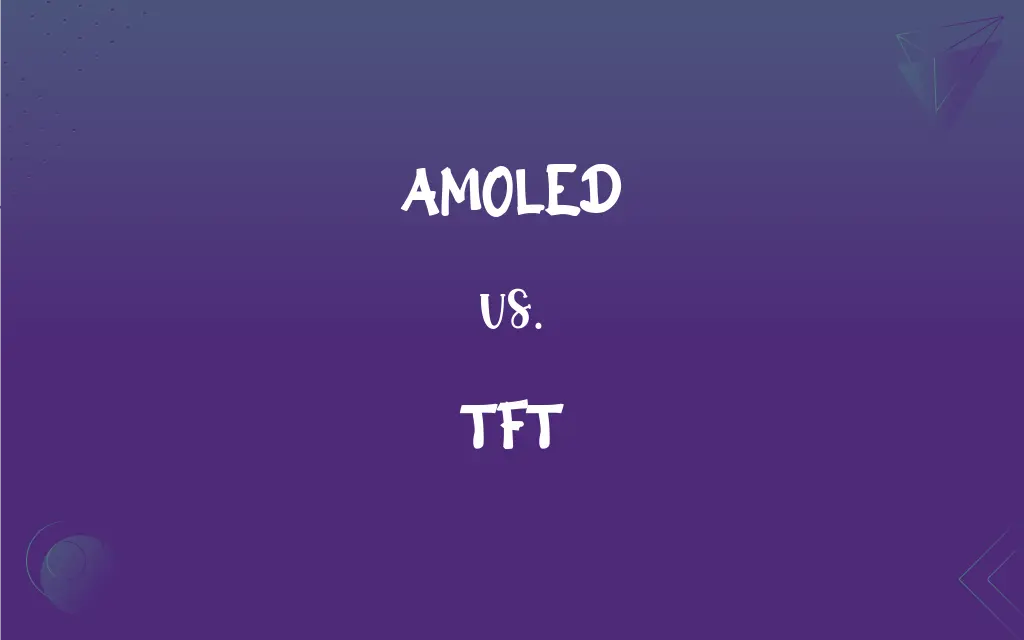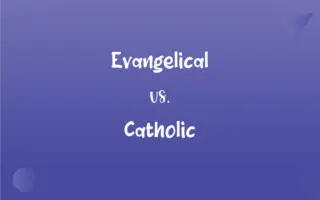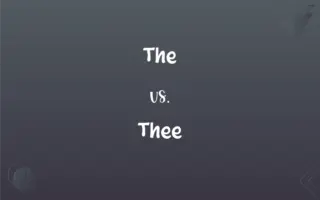AMOLED vs. TFT: What's the Difference?
Edited by Aimie Carlson || By Janet White || Published on February 22, 2024
AMOLED (Active Matrix Organic Light Emitting Diode) displays offer vibrant colors and deep blacks, while TFT (Thin Film Transistor) LCDs are more common, with lower contrast.

Key Differences
AMOLED, which stands for Active Matrix Organic Light Emitting Diode, is a display technology known for its high contrast ratio and vibrant colors. Each pixel in an AMOLED display emits its own light, leading to deeper blacks and a wider range of colors. TFT, short for Thin Film Transistor, is a type of LCD (Liquid Crystal Display) technology. TFT screens use a backlight to illuminate the display, which can result in less vibrant colors and lower contrast ratios compared to AMOLEDs.
Energy efficiency is a notable advantage of AMOLED displays since pixels can be turned off completely, which saves power, especially when displaying black or dark images. TFT LCDs, however, are generally less energy efficient as the backlight is always on, even when displaying blacks, which are actually dark grays.
Viewing angles are another area where AMOLED displays excel. They offer wide viewing angles with minimal color shifting, making them ideal for devices where the screen is viewed from different angles. TFT displays often suffer from limited viewing angles, resulting in color and contrast changes when viewed from the side.
In terms of manufacturing and cost, TFT LCDs are more common and less expensive to produce than AMOLED screens. This makes TFT a popular choice for budget and mid-range devices. AMOLED displays, being more expensive to manufacture, are typically found in high-end devices where cost is less of a constraint.
Durability and lifespan can differ between the two. AMOLED screens are susceptible to screen burn-in, where images can get permanently imprinted on the display over time. TFT LCDs, while not immune to degradation, generally do not suffer from burn-in to the same extent as AMOLEDs.
ADVERTISEMENT
Comparison Chart
Display Technology
Organic Light Emitting Diode
Liquid Crystal Display with Thin Film Transistors
Contrast and Color
High contrast, vibrant colors
Lower contrast, less vibrant colors
Energy Efficiency
More energy efficient, especially in dark modes
Less energy efficient due to constant backlight
Viewing Angles
Wide viewing angles with consistent colors
Narrower viewing angles with color shift
Cost and Availability
More expensive, common in high-end devices
Less expensive, widely used in various devices
ADVERTISEMENT
AMOLED and TFT Definitions
AMOLED
AMOLED is a display technology with self-illuminating pixels.
The AMOLED screen on my phone delivers stunning visuals.
TFT
Generally free from burn-in issues.
I don’t worry about screen burn-in with my TFT TV.
AMOLED
Energy-efficient, especially in displaying dark images.
My AMOLED phone screen saves battery life with its dark mode.
TFT
TFT is a common type of LCD with thin film transistors.
My budget laptop's TFT screen is bright and clear.
AMOLED
Prone to screen burn-in over time.
I avoid static images on my AMOLED screen to prevent burn-in.
TFT
Viewing angles can result in color and contrast shift.
Colors change slightly on my TFT screen when viewed from the side.
AMOLED
Known for deep blacks and vibrant colors.
Watching movies is amazing on the AMOLED display because of its color depth.
TFT
Provides consistent backlighting for the display.
The TFT LCD on my monitor ensures even lighting across the screen.
AMOLED
Features wide viewing angles without color distortion.
The AMOLED display looks great from any angle.
TFT
Less energy efficient due to continuous backlight use.
The TFT display uses more battery than AMOLED screens.
FAQs
Are AMOLED displays better than TFT?
AMOLEDs generally offer better contrast and color but are more expensive.
Is AMOLED more energy-efficient than TFT?
Yes, particularly when displaying darker images.
What is TFT?
A type of LCD display that uses thin film transistors.
Do TFT displays have good color accuracy?
They have decent color accuracy but not as vibrant as AMOLED.
What is AMOLED?
A type of display with self-illuminating organic diodes.
Can TFT displays be viewed from different angles?
They can, but color and contrast may shift.
Do AMOLED screens have better viewing angles?
Yes, AMOLED screens maintain color and contrast at wider angles.
Do AMOLED displays suffer from burn-in?
Yes, AMOLED can experience burn-in over time.
What is the lifespan of a TFT display?
TFT displays also have a long lifespan, often without burn-in issues.
Is the backlight always on in TFT displays?
Yes, the backlight in TFT displays is always on.
Are TFT displays cheaper than AMOLED?
Generally, TFT displays are more budget-friendly.
Can AMOLED display true black?
Yes, as individual pixels can turn off completely.
Do TFT screens work well in direct sunlight?
They are reasonably visible, but AMOLED might perform better.
Can TFT and AMOLED be used for gaming?
Yes, both can be used, but AMOLED might offer a better experience for fast-paced games.
Are TFT displays prone to burn-in?
No, TFT screens are generally not prone to burn-in.
How long do AMOLED screens last?
They have a good lifespan but can degrade with burn-in over time.
Is color saturation better in AMOLED?
Yes, AMOLED displays generally have higher color saturation.
What devices use AMOLED screens?
Mostly high-end smartphones and TVs.
What devices commonly use TFT displays?
Budget and mid-range phones, laptops, and monitors.
Are AMOLED screens used in budget devices?
Rarely, as they are more expensive to produce.
About Author
Written by
Janet WhiteJanet White has been an esteemed writer and blogger for Difference Wiki. Holding a Master's degree in Science and Medical Journalism from the prestigious Boston University, she has consistently demonstrated her expertise and passion for her field. When she's not immersed in her work, Janet relishes her time exercising, delving into a good book, and cherishing moments with friends and family.
Edited by
Aimie CarlsonAimie Carlson, holding a master's degree in English literature, is a fervent English language enthusiast. She lends her writing talents to Difference Wiki, a prominent website that specializes in comparisons, offering readers insightful analyses that both captivate and inform.







































































